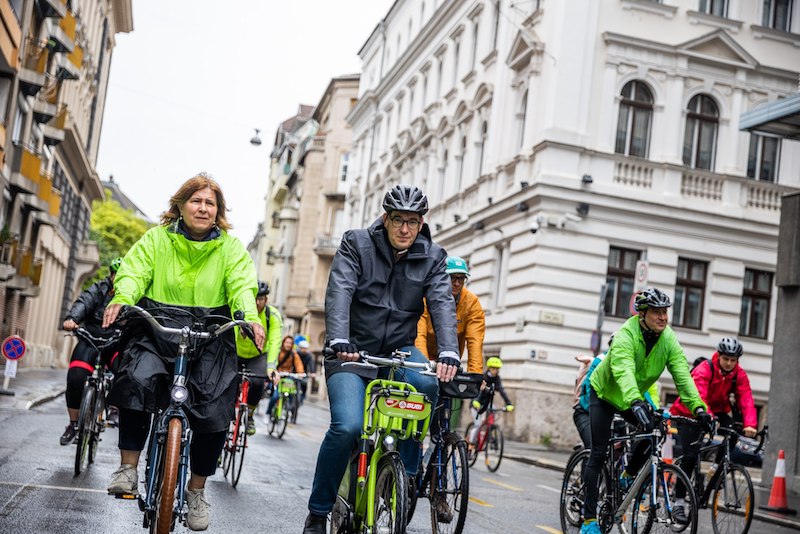Hi from Rome,
Few times have I seen so much enthusiasm as during our last editorial meeting, when some colleagues suggested talking about bicycles.
For some of us, cycling is still a forbidden dream. I have even forgotten how to dream: Rome is a jungle for cyclists, and the green dream can easily turn into a nightmare if a city does not make itself comfortable for two wheels.
Untangling traffic is a struggle for survival, and not everyone has the courage of our colleague Holger, who in Tallinn fights every day to take his children to school on a cargo bike.
In Budapest, Viktoria took back her right to the bicycle at the age of 40: she learned to ride when the pandemic emptied the streets. But within a few months she was back to the old world, where the fight between bikes and cars has now reached political dimensions.
My colleagues’ enthusiasm for cycling enticed me back to dream of bike-friendly European cities. After all, for some it is already a reality. We asked our Dutch colleague how this can be achieved.
Francesca De Benedetti,
this week’s Editor-in-Chief

It’s evening rush hour and time to pick up the kids from the kindergarten. So I climb into my cargo bike, which I bought last autumn with my wife.
Tallinn has never been a bike-friendly city, but the concept of three-wheeled cargo bikes is completely new. There were probably no more than a dozen of these bikes in the Estonian capital, when we joined the peloton.
Our way home takes us through streets where bike and car lanes are not physically separate. Every day I feel how car drivers do not notice us on the road.
Situations vary from trucks and delivery vehicles stopping on the bike lane to drop off goods at nearby shops and cafés to cars queuing in a traffic jam, and leaning to the right side of the road, where they steal space from bikers. While small bikes and electric scooters can ease past, a larger bike like ours must sit and wait.
Often, drivers don’t look into the wing mirror to see if a bike is coming. This is where it gets dangerous for us.
On the narrow bike lane, I have developed my own kind of passive-aggressive reaction to help drivers learn and get used to paying attention to us. Sometimes I knock on their window when driving past. Then I give a long, cold glance straight into the eyes of the driver. I even ask the kids to wave to the driver.
It is not the drivers’ fault that they are not accustomed to sharing the road with vehicles such as ours. The real problem lies in the municipality, which hasn’t developed adequate biking lanes.
But I take it as my small task to nudge for change. Day by day. Step by step. Eventually the drivers will accept us as a natural part of the traffic.

The video lasts fewer than 30 seconds, but has made the rounds on social networks. In Paris on Sunday 11 June, French Green MP Sandrine Rousseau did not hesitate to intervene in a scuffle between a cyclist and a cab driver on her way to the market.
These quarrels have become far too frequent in the French capital, where the number of bike journeys has increased by 79% between 2019 and 2022. The number of cycle paths has also boomed, but not at the same rate, and many drivers still have trouble sharing the road with cyclists, who sometimes risk their lives on the streets. The number of cyclists involved in accidents reached 1,611 in 2022, compared with 676 three years earlier.
In a couple of months, Paris’s roads should be less overcrowded. In a local referendum in early April, inhabitants voted in favour of banning self-service scooters, which Parisians have heavily criticized since their introduction in 2018.

Cycling is deeply ingrained in Dutch culture, with over 23.4 million bicycles out of a population of 17.5 million. This has evolved over decades, starting in the 1890s when the flat terrain and compact urban areas made cycling a convenient choice of transport. Following World War II, the Netherlands prioritised cycle networks to connect cities, towns and rural areas.
In the 1970s, cycling advocacy groups emerged, and the government responded with significant investment in cycling infrastructure, and focusing on “slow traffic”. Cities and towns were designed with separated bike lanes, bike-friendly intersections, and traffic-calming measures.
In big Dutch cities, car-free areas and pedestrian zones are becoming more common. Amsterdam’s city centre has restricted car access with no major opposition. Generally, locals like it this way: at the end of last century, when cars threatened to take over, thousands protested against giving more space to four-wheels.
Nowadays, all train stations have huge bike parks for those who bike to take the train. Bike-sharing programs have also been implemented across Dutch cities, offering easy access to bicycles for short-term use. Individuals can easily rent a bike at a train station, use it to reach their destination, and return it at another location. It costs around 4.45 euros per 24 hours, which is usually reimbursed by employers.
Dutch companies often provide incentives for employees to commute by bike or public transport. Some offer tax benefits, reimbursements for bike expenses, or subsidised public transport passes. Cycling education is also integrated into the school curriculum, emphasising road safety and cycling skills from a young age.
The Dutch cycle more than 15 billion kilometres a year, with urban planners ensuring essential facilities (supermarkets, shopping and recreational areas, hospitals, schools and stations) are within cycling distance. However, the state secretary for infrastructure Vivianne Heijnen has emphasised the need for continued effort, as almost half of car journeys are shorter than 7.5 kilometres, a distance easily covered by cycling.

“There is a car chase in Budapest. The administration considers those who dare to get into cars as criminals.”
– Gergely Gulyás, Prime Minister’s Chief of Staff
‘Car chase’ could easily be the title of a movie in Hungary, with Gergely Karácsony, Budapest’s liberal mayor, as the lead.
To tell the truth, the Hungarian capital has never been friendly to cyclists. Cars are status symbols here, and the city has always favoured motorists. So, when Karácsony was elected in 2019, his actions to transform the city faced controversy.
But the fiercest attacks did not come from the inhabitants, but from the right-wing populist government, in an attempt to woo voters and make the opposition mayor’s life difficult. When Karácsony cycled to work, politicians attacked him for not driving. When he opened a bike lane or wanted to reform parking, he was called an “enemy of cars” – along with every cyclist in the city.
Just like that, Budapest has become an example of how politics can make enemies of cyclists – while the inhabitants suffer the consequences.

After the full-scale war in Ukraine started, six biking organisations in Ukraine launched an international campaign #BikesForUkraine. Now they collect foreign donations to help deliver bicycles to war-torn communities. Initiative participant Maryna Bludsha tells more.
Why does Ukraine need more bicycles?
In times of hostilities, road networks and public transports system become ruined: some buses catch fire, or are stolen by invaders, such as in Kherson. Also, there’s often lack of fuel. Thus, a bicycle becomes the only reliable mode of transport. Right after Russia’s full-scale invasion began, we started receiving requests for bikes. People still need more than we can provide: as of June 11, we have given 1,391 bikes to local communities in Ukraine, but we have requests for 2,974.
We often give bikes to volunteers who distribute medicine, goods and food. Also, there are doctors, social workers and local authorities who need bikes. These are mostly from war-torn regions, but we also help other communities which have many internally displaced persons and need to provide more services.
Who provides the donations?
Most help comes from the EU countries, which includes 40 out of 50 of our key supporters, especially Germany, The Netherlands and Lithuania ― people or organisations help with either money, so we can to buy new bicycles in Ukraine, or they collect bikes from locals in their area. Often they also repair the bikes before sending them to Ukraine. Our Berlin partners, Changing Cities, have organised bike repair gatherings, so people could help Ukraine in this way.
In the first days of Russia’s full-scale invasion, Kyiv cyclists organised a volunteer service to deliver urgent aid. Do you know any other examples of how bicycles can be useful in war?
In Kyiv we have a bike courier company called CargoCult, which also delivers goods to people and organisations in need. Traffic in the city was jammed at checkpoints and in queues, and bikes turned out to be the fastest way to get around.
Thanks for reading the 35th edition of European Focus,
My Hungarian colleague has told me that a special pan-European cycle path passes through Budapest. Did you know that? After all this talking about bicycles, I feel like picking up a map of the cycle paths and taking my bike back.
See you next Wednesday!
Francesca De Benedetti







